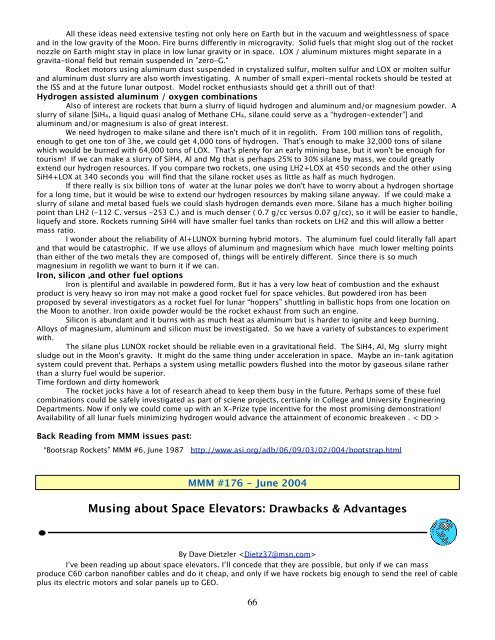Space Transportation - mmmt_transportation.pdf - Moon Society
Space Transportation - mmmt_transportation.pdf - Moon Society
Space Transportation - mmmt_transportation.pdf - Moon Society
Create successful ePaper yourself
Turn your PDF publications into a flip-book with our unique Google optimized e-Paper software.
All these ideas need extensive testing not only here on Earth but in the vacuum and weightlessness of space<br />
and in the low gravity of the <strong>Moon</strong>. Fire burns differently in microgravity. Solid fuels that might slog out of the rocket<br />
nozzle on Earth might stay in place in low lunar gravity or in space. LOX / aluminum mixtures might separate in a<br />
gravita-tional field but remain suspended in "zero-G."<br />
Rocket motors using aluminum dust suspended in crystalized sulfur, molten sulfur and LOX or molten sulfur<br />
and aluminum dust slurry are also worth investigating. A number of small experi-mental rockets should be tested at<br />
the ISS and at the future lunar outpost. Model rocket enthusiasts should get a thrill out of that!<br />
Hydrogen assisted aluminum / oxygen combinations<br />
Also of interest are rockets that burn a slurry of liquid hydrogen and aluminum and/or magnesium powder. A<br />
slurry of silane [SiH4, a liquid quasi analog of Methane CH4, silane could serve as a “hydrogen-extender”] and<br />
aluminum and/or magnesium is also of great interest.<br />
We need hydrogen to make silane and there isn't much of it in regolith. From 100 million tons of regolith,<br />
enough to get one ton of 3he, we could get 4,000 tons of hydrogen. That's enough to make 32,000 tons of silane<br />
which would be burned with 64,000 tons of LOX. That's plenty for an early mining base, but it won't be enough for<br />
tourism! If we can make a slurry of SiH4, Al and Mg that is perhaps 25% to 30% silane by mass, we could greatly<br />
extend our hydrogen resources. If you compare two rockets, one using LH2+LOX at 450 seconds and the other using<br />
SiH4+LOX at 340 seconds you will find that the silane rocket uses as little as half as much hydrogen.<br />
If there really is six billion tons of water at the lunar poles we don't have to worry about a hydrogen shortage<br />
for a long time, but it would be wise to extend our hydrogen resources by making silane anyway. If we could make a<br />
slurry of silane and metal based fuels we could slash hydrogen demands even more. Silane has a much higher boiling<br />
point than LH2 (-112 C. versus -253 C.) and is much denser ( 0.7 g/cc versus 0.07 g/cc), so it will be easier to handle,<br />
liquefy and store. Rockets running SiH4 will have smaller fuel tanks than rockets on LH2 and this will allow a better<br />
mass ratio.<br />
I wonder about the reliability of Al+LUNOX burning hybrid motors. The aluminum fuel could literally fall apart<br />
and that would be catastrophic. If we use alloys of aluminum and magnesium which have much lower melting points<br />
than either of the two metals they are composed of, things will be entirely different. Since there is so much<br />
magnesium in regolith we want to burn it if we can.<br />
Iron, silicon ,and other fuel options<br />
Iron is plentiful and available in powdered form. But it has a very low heat of combustion and the exhaust<br />
product is very heavy so iron may not make a good rocket fuel for space vehicles. But powdered iron has been<br />
proposed by several investigators as a rocket fuel for lunar “hoppers” shuttling in ballistic hops from one location on<br />
the <strong>Moon</strong> to another. Iron oxide powder would be the rocket exhaust from such an engine.<br />
Silicon is abundant and it burns with as much heat as aluminum but is harder to ignite and keep burning.<br />
Alloys of magnesium, aluminum and silicon must be investigated. So we have a variety of substances to experiment<br />
with.<br />
The silane plus LUNOX rocket should be reliable even in a gravitational field. The SiH4, Al, Mg slurry might<br />
sludge out in the <strong>Moon</strong>'s gravity. It might do the same thing under acceleration in space. Maybe an in-tank agitation<br />
system could prevent that. Perhaps a system using metallic powders flushed into the motor by gaseous silane rather<br />
than a slurry fuel would be superior.<br />
Time fordown and dirty homework<br />
The rocket jocks have a lot of research ahead to keep them busy in the future. Perhaps some of these fuel<br />
combinations could be safely investigated as part of sciene projects, certianly in College and University Engineering<br />
Departments. Now if only we could come up with an X-Prize type incentive for the most promising demonstration!<br />
Availability of all lunar fuels minimizing hydrogen would advance the attainment of economic breakeven . < DD ><br />
Back Reading from MMM issues past:<br />
“Bootsrap Rockets” MMM #6, June 1987 http://www.asi.org/adb/06/09/03/02/004/bootstrap.html<br />
MMM #176 - June 2004<br />
Musing about <strong>Space</strong> Elevators: Drawbacks & Advantages<br />
By Dave Dietzler <br />
I’ve been reading up about space elevators. I’ll concede that they are possible, but only if we can mass<br />
produce C60 carbon nanofiber cables and do it cheap, and only if we have rockets big enough to send the reel of cable<br />
plus its electric motors and solar panels up to GEO.<br />
66















